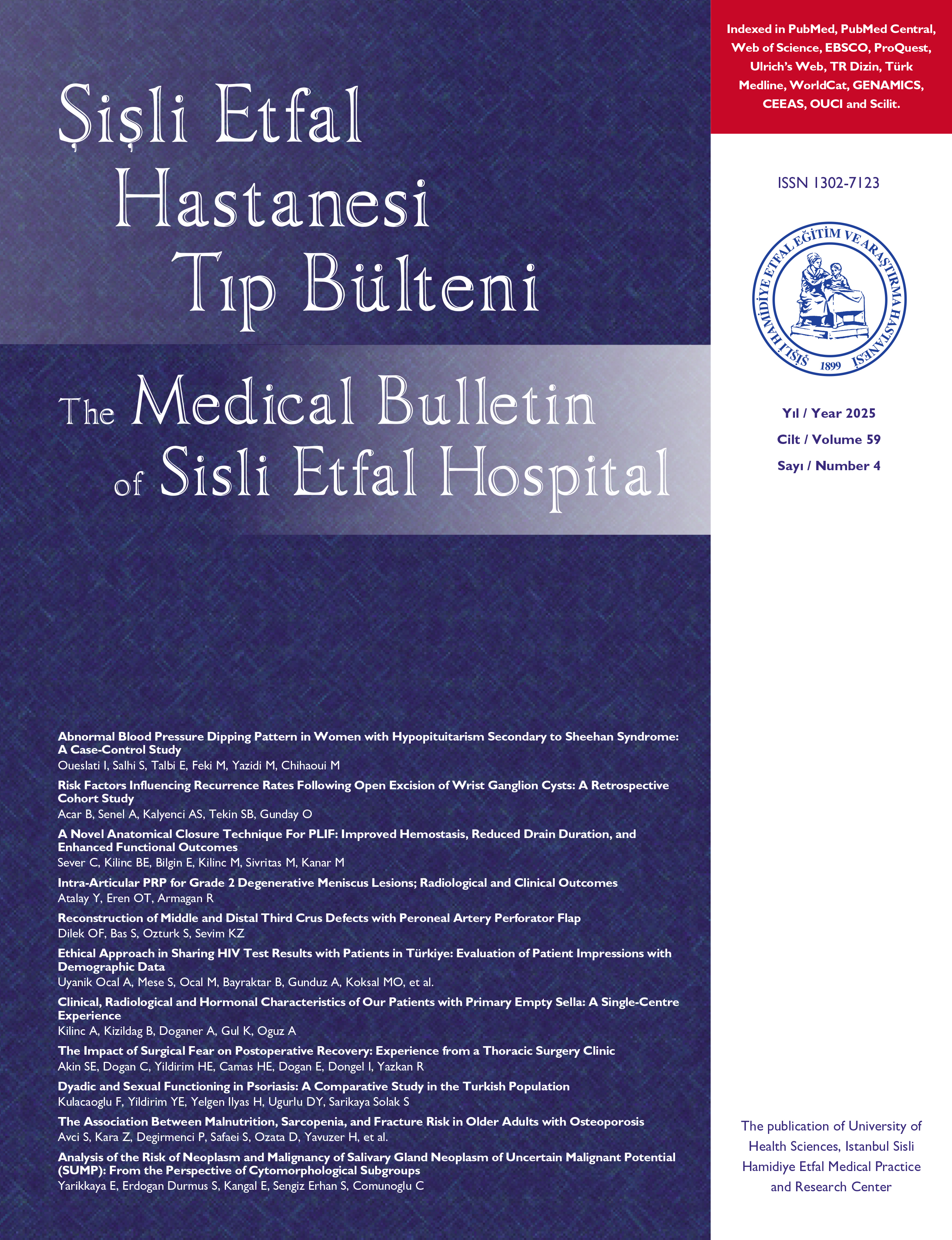
Evaluation of Magnetic Resonance (MR) Findings in Patients with Refractory Epilepsy
Fatma Cetinkaya Cat1, Mehmet Sait Okan21Department of Child Health and Diseases, Gaziosmanpasa Taksim Training and Research Hospital, Istanbul, Turkey2Department of Pediatric Neurology, Uludag University Faculty of Medicine, Bursa, Turkey
Objectives: Epilepsy is characterized as a tendency towards recurrent seizures and it is a significant health problem in the world and one of the most common severe neurologic disorders among children. This study aims to evaluate the outcome of magnetic resonance imaging in determining the etiology in patients with refractory epilepsy and to reveal pathologies that may have the potential to be treated with methods, such as epileptic surgery.
Methods: Data were obtained from the patient files of the patients diagnosed with epilepsy and monitored for at least two years between 01.01.2009-12.31.2012 in the Uludag Faculty of Medicine, the Division of the Pediatric Neurology. File records of the patients, age, sex and MRI findings of the patients were recorded.
Results: One hundred twenty were girls (49%) and 125 were male (51%) of the cases. The age range ranged from 1 to 18 years and the median value was 8.3 (1-18) years. One hundred twenty of the 245 patients who met the diagnostic criteria for resistant epilepsy was found as well controlled. In patients with resistant epilepsy, the findings of these two groups of patients were compared concerning MR findings. Among all patients, 154 (62.8%) patients were found to have MR pathology. Of these patients, 83 (53.9%) were in the resistant group and 71 (46.1%) were in the well-controlled group. There was no significant difference in the presence of MR findings between the two groups (p=0.354). The highest incidence (24.8%) of the encephalomalacia in patients in the resistant group may explain the association of perinatal hypoxia with resistance development.
Conclusion: If patients with epilepsy can be predicted early in the disease, which group of the patients will not respond well to medical treatment; unlike other patients, different treatment modalities, such as antiepileptic use, vagal nerve stimulation, ketogenic diet and epilepsy surgery, can be applied to this group of the patients. We think that clinicians can guide the planning of treatment of the MR findings.
Keywords: Child, epilepsy; magnetic resonance; resistant epilepsy.
Dirençli epilepsili hastalarda manyetik rezonans (MR) bulgularının değerlendirilmesi
Fatma Cetinkaya Cat1, Mehmet Sait Okan21Gaziosmanpaşa Taksim Eğitim ve Araştırma Hastanesi Çocuk Sağlığı ve Hastalıkları, İstanbul2Uludağ Üniversitesi Tıp Fakültesi Çocuk Nöroloji Anabilim Dalı, Bursa
AMAÇ
Epilepsi tekrarlayan nöbet eğilimi ile karakterize tüm dünyada yaygın olarak görülen önemli bir sağlık problemi olup aynı zamanda çocuklarda en sık görülen ciddi nörolojik bozukluklardan biridir. Bu çalışmanın amacı dirençli epilepsili hastalarda etyolojiyi belirlemede manyetik rezonans görüntülemenin sonuçlarını değerlendirmek ve epileptik cerrahi gibi yöntemlerle tedavi şansı olabilecek patolojileri ortaya koymaktır.
GEREÇ VE YÖNTEMLER
Uludağ Üniversitesi Tıp Fakültesi Çocuk Nöroloji Bilim Dalı Polikliniğinde epilepsi tanısı almış, en az iki yıldır izlemde olan 01.01.2009 31.12.2012 tarihleri arasında takip edilen hastaların dosyaları incelenerek veriler elde edildi. Hastaların dosya kayıtlarından; hastaların yaşı, cinsi ve MR bulguları kayda alındı.
BULGULAR
Vakaların 120si kız (%49), 125i erkek (%51) çocuktan oluşmaktaydı. Yaş aralığı 1 ile 18 yaş arasında değişmekte olup median değer 8,3 (1-18) yaş olarak bulundu. Dirençli epilepsi tanı kriterlerine uyan 245 hastadan 120si iyi kontrollü grup olarak bulundu. Dirençli epilepsili hastalarda mr bulguları açısından bu iki grup hastanın bulguları karşılaştırıldı. Tüm hastalar arasında 154 (%62,8) hastanın MR sonucunda patoloji olduğu tespit edildi. Bu hastaların 83ü (%53,9) dirençli grupta, 71i (%46,1) iyi kontrollü grupta yer aldı. İki grup arasında MR bulgularının varlığı açısından anlamlı bir fark bulunmadı (p=0,354). Dirençli gruptaki hastalarda en fazla (%24,8) ensefalomalazi görülmesi, perinatal hipoksinin direnç gelişimi ile ilişkisini açıklayabilir.
SONUÇ
Epilepsili hastalarda hangi hasta grubunun tıbbi tedaviye iyi yanıt vermeyeceği hastalığın erken dönemde tahmin edilebilirse diğer hastalardan farklı olarak bu hasta grubuna erken yeni kuşak antiepileptik kullanımı, vagal sinir uyarımı, ketojenik diyet, uygun vakalara epilepsi cerrahisi gibi değişik tedavi yöntemleri uygulanabilir. MR bulgularının tedavi planlanmasında klinisyenlere yol gösterici olabileceğini düşünüyoruz. (SETB-2018-09-129)
Anahtar Kelimeler: epilepsi, dirençli epilepsi, çocuk, manyetik rezonans
Manuscript Language: Turkish



















